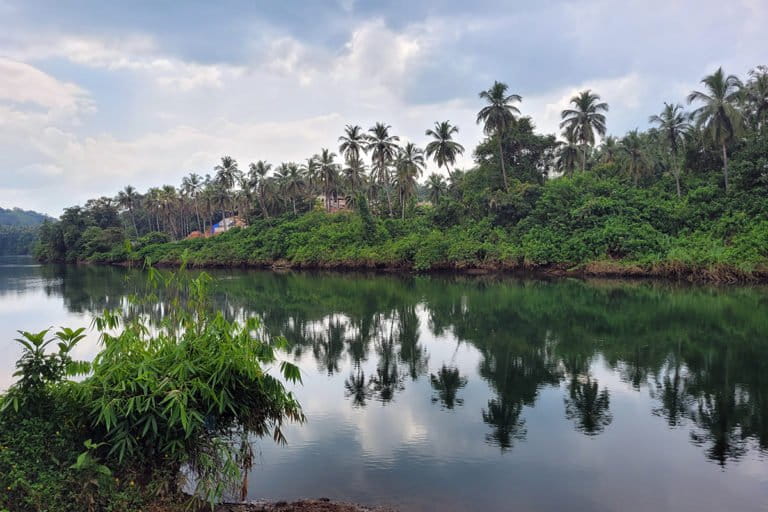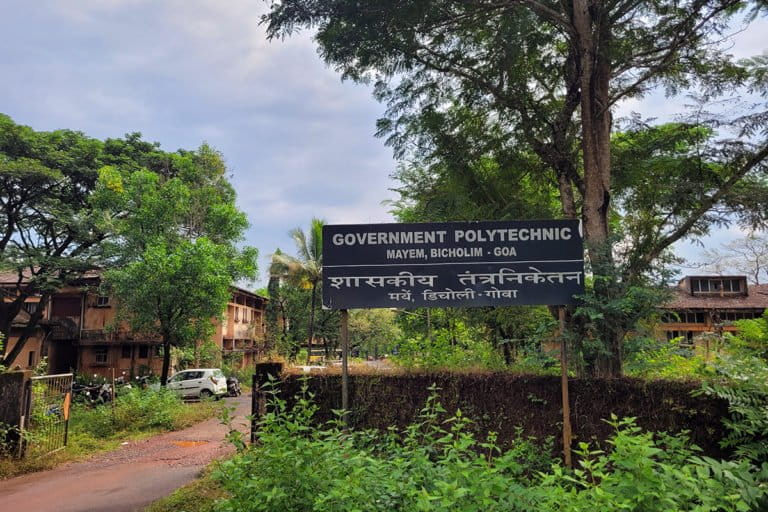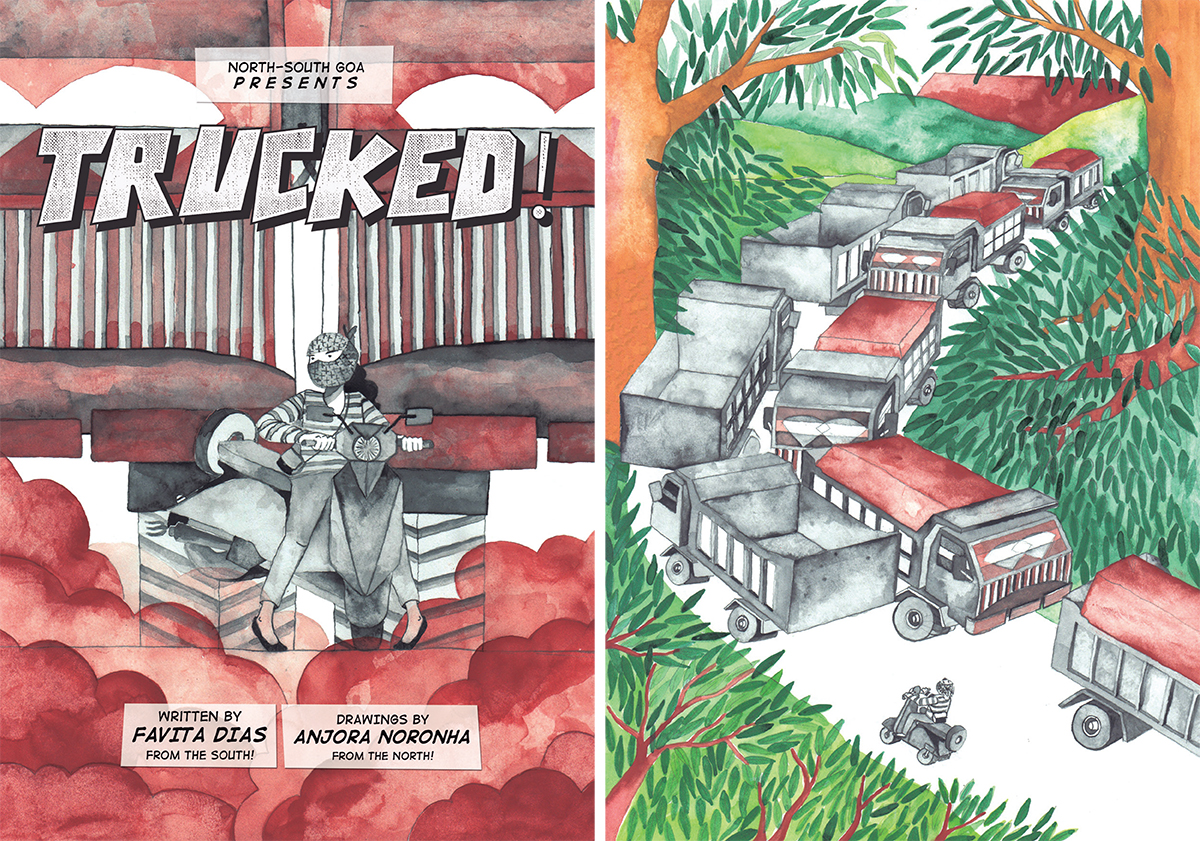- With state elections around the corner, different political parties in Goa are putting out their agendas to resume mining.
- Ever since mining halted in Goa, the youth living in the mining belt finds itself caught in a dilemma. On one hand, it is happy to see environmental destruction come to an end, but on the other hand, it is stung by the loss of livelihood of their parents.
- As unemployment in the state grows, the young are desperate for job security and uncertain about their future.
When Abhijit Kavalekar was in third grade, he used to walk to school with a group of friends. “My school was about 15 minutes away. We walked in a cloud of dust. Even our homes and balconies were covered in dust,” he recalls.
“I remember there used to be many trucks in a line on the road leading up to our school. All the time. Not even two metres of gap between them. No room for a person to pass through. They created a lot of dust and noise pollution. We had to hold hands, cover our faces and walk carefully,” he told Mongabay-India.
This was a scenario nearly 15 years ago, in the riverside village of Mirabag, in Sanvordem, the heart of Goa’s southern mining belt. Today, things are different. The village is an oasis of calm. The river Sal flows free of barges, the coconut and betel nut trees are no longer shrouded in dust, and there is no incoming traffic of the trucks. “My village is beautiful,” said the 23-year old Kavalekar, “but our people have no jobs.”

As election fever takes hold in Goa, various political parties are putting out firm stances on restarting mining in the state. The state elections for Goa’s 40-member legislative assembly are scheduled for February 2022. The ruling Bharatiya Janata Party (BJP) is steadfast on its decision to restart mining via auctions through the Goa Mineral Development Corporation. Amongst the opposition parties, the Indian National Congress says it fully supports the resumption of mining. Aam Aadmi Party (AAP) has promised to revive mining within six months and provide an allowance of Rs. 5,000 a month to mining-dependent households till mining is restored. The Mamata Banerjee-led All India Trinamool Congress (AITC), the latest entrant to the political mix of the Western Indian coastal state, is supporting the manifesto brought forward by the non-profit Goa Foundation, that demands sweeping regulations in the mining sector.
The youth, mainly 20-somethings, have seen it all – they grew up in a region that was wholly affected by and dependent on mining, witnessed the devastating impact on its environment, and also experienced the aftermath of its abrupt closure in 2012, following litigations by environmentalists and reports on illegal mining. There has been nearly a decade of no mining in Goa, a sector, along with the tourism and pharmaceutical industry, that was once considered one of the most important economic contributors of the state’s GSDP (Gross State Domestic Product).
![Abhijit Kawalekar [left] with his friend at Mirabag village. Photo by Supriya Vohra.](https://imgs.mongabay.com/wp-content/uploads/sites/30/2021/12/10114630/edit-Abhijit-Kawalekar-left-with-his-friend-at-Mirabag-village_SupriyaVohra.jpg)
Dependence on the sector for livelihoods
How do the young people assess the situation? Kavalekar works as an electronics engineer at Bharat Petroleum Corporation Limited (BPCL), at their Goa station in Verna. He studied electronic engineering and telecommunications at Goa Engineering College. He has a younger brother who works with a leading private bank. His father, now retired, used to work as a machine operator at Sesa Goa. The 23-year-old has no interest in mining.
“I love engineering. In 2012, when mining shut down, I think people’s aspirations began to move away from mining. I don’t think there is any point in even thinking about going into this sector,” he told Mongabay-India.
Dependence on the mining sector, when the industry was functional, came in various forms. The first is direct employment, as engineers, surveyors, geologists, managers, supervisors, clerks, operators of machines, technicians, workers, labourers for loading and unloading, etc. According to numbers provided during the legislative assembly session in February 2020, there were nearly 4,000 people employed directly by the mining sector.
In fact, two courses in mining engineering also existed in the state till 2015 and 2019. A diploma course in mining engineering at the Goa Polytechnic Institute in Bicholim began in 1978 and a degree in mining engineering at Goa Engineering College that began in 2011. The intake for both courses was 30 each.

A former faculty member at the polytechnic, who wishes to remain anonymous, told Mongabay-India that almost all students belonged to the state’s mining belt. “Valpoi, Bicholim, Sankhalim and Curchorem – most of the students came from the mining belt,” he explained. “Apart from having a good idea about what the mining was like, they also wanted to be in Goa, close to their homes,” he said.
He explained that mining in Goa was different from mining in other states because the mining belt was not as isolated or remote from the main towns and villages as may be the case in other states. “So our students joined with this mindset of getting absorbed in the mining sector within Goa itself. And it was good because there was 100 percent placement, everyone got a job.”
This proximity of the mining belt to the villages also became a bone of contention, as the environmental damage directly affected the people. The pollution and chaos caused by the movement of trucks are well documented in S.T. Puttaraju’s 2014 study. It shows that the roads were not designed for the plying of mining traffic.
But things took a downward turn from 2012 when mining halted in the state. The number of students began to dwindle, and by 2015, the diploma course was shut down. The degree course saw its last batch in 2019. “It is all tied to how the sector is doing in the state,” said the professor.
The other form of dependence came through various ancillary activities that were associated with mining both directly and indirectly. Transportation of the ore was one of the most crucial activities. There were approximately 12,000 truck owners till 2012. When mining shut down, the truck owners went into deep debt. The mining companies, on the other hand, having externalised their major costs of transportation and machinery, have been able to minimise their liabilities.
The abrupt closure of mining-affected a number of families. Some lost their jobs, some lost their pension, some sunk in debt. It also created a stark divide within village communities — the ones entirely dependent on it came to be pro-mining, and those affected by it came to be anti-mining.
For instance, Rahul Tripathi, in his 2019 research paper Marginality and Contestations – A Case of Mining Affected in Goa gives a granular picture of this complication. The paper is a study of Cawrem, a village in Quepem taluka of South Goa, where a tribal community fought against illegal miners. “From my conversations with the young people of the village, it was clear that they wanted mining to resume because it was a source of livelihood for many. But at the same time, they were most defiantly against indiscriminate mining,” said Tripathi.
Favita Rochelle Dias, assistant professor of sociology at Goa University recalls a time during her graduation days in college in 2011 when the Shah Commission reports were coming out. “We used to have these classroom discussions around various issues plaguing Goa,” the 30-year-old told Mongabay-India.
“One time the teacher wanted to discuss issues around mining. I think I was the only person who said that my father works in the sector, and that is how I am able to afford education,” she said. Her teacher reprimanded her and asked why her father couldn’t get a job elsewhere. “My father was in his late forties at the time. He has worked as a barge operator for many years. How can you suddenly expect him to just find another job?” she questioned. In 2012, when mining came to a halt in the state, her father went without a job. “It was a difficult time for us, we were entirely dependent on my mother’s income, who worked as a hospital maid.”
Read more: Goa forms mineral development corporation, hopes to revive mining
Perils of an extractive industry on the environment
Along with the loss of livelihoods, the youth, at the same time, have witnessed the devastating impact of mining on the land, water and air from close proximity. This has played an important role in shaping their views on the sector. In September 2015, artist Orijit Sen organised a comic-strip-making workshop for second-year students of Goa College of Art situated in Sankhali, a town at the edge of mining sites.
The workshop was called ‘Digging Deeper’ and students were required to create comic strips related to mining. They visited mining sites and villages, documented what they saw through sketches, and came back to class to create visual stories around what they saw. The stories they tell through their illustrations look at the coarse impacts of mining and its closure on the lives and the land of the people.
Dias wrote about her experience travelling through a road full of trucks for the first time, to join the protests in Cawrem, one of the first villages in Goa that stood up against mining. “The people of the village are from the same tribe as me. I wanted to show solidarity as a community member. It was my first time riding the distance on that road and I was terrified throughout. So many trucks, I felt I was going to bang into them,” she told Mongabay-India.

The resulting graphic novel, Trucked, by Favita Dias and Anjora Noronha drew a vivid picture of the devastating impact of mining on the lives of the people. Similarly, in A Journey to Reality, Raviraj Naik walks us through the village of Sanquelim, where the wells have dried up, the paddy is destroyed, and the sleeping truck wheels rest on stone, and the people smile with sadness. In Beauty with Destruction, Ashish Naik takes us through the village of Pissurlem, a village that was once rich with water and is now entirely dependent on tankers.
“The majority of the students were from mining villages,” Orijit Sen told Mongabay-India. “Although many of them were too shy to give their opinions during discussions, they were very expressive in their art,” he said.
“Goan identity is strongly rooted to the land,” said Sinead D’Silva, a research fellow at the Institute of Social Sciences, University of Lisbon. According to her, the natural landscape is deeply entrenched into how young people relate to the state.
“Goa is rural or peri-urban in the sense that there is always such a presence of the environment that it has to be taken into account, unlike in more urban regions. Perhaps this can be traced back to the 80s when a strong environmental movement emerged. This is not to say that such a relationship did not exist previously, but it does have some prominence in how identity manifests in the state. The young people of Goa today have witnessed changes in multiple different ways over the years and so engaging with industries like mining and tourism may raise internal conflicts. It’s just there – this connection with the water, the land, the source of their food,” she explained to Mongabay-India.

Read more: The precarious journey of Goa’s mining-affected and dependent people
What does Goa’s youth want?
It is this dichotomy that the young people of Goa’s mining belt carry. Having seen the destruction from up-close, they don’t appreciate the sector for what it does to the environment. But having seen their parents suffer from the implications of economic loss, they feel stung about the situation.
Abhijeet Naik works as an accountant at a local private firm in Mapusa. The 26-year old is from Maem, a village where the paddy was completely destroyed because of mining. His father is a farmer and his land does not produce anything anymore. Naik is furious. “In the last 15 years, not a single person in our village has managed to get a job in mining,” he told Mongabay-India. “They created no opportunity for us. People with prior jobs in the sector stuck around. But no new person has got a job in our village. And in turn, they have destroyed everything,” he said.
The sentiment is echoed by 30-year old Surendra Gawade from Sonshi, another village destroyed by mining. Gawade works at a toy factory about 30 km away from his village as a supervisor. “They could have set up some industrial zone here like they have done in Verna with the pharmaceutical company. We have literally nothing left in our village. Nothing to work on, nothing to grow,” he told Mongabay-India.
Unemployment in Goa has been on an uptick. According to the monthly percentage figure offered by the Centre for Monitoring Indian Economy (CMIE), it was at its peak in April 2021 at 25.7 percent.
James Fernandes, an educator and pastor based in Quepem, South Goa explained that any local will first and foremost look for a job in their own area. “If railways or any industry is set up in the area, they will go for that job. The young have witnessed the destruction and the precarious nature of the mining industry first-hand. They will no longer be interested in it,” he said. He added that young people of lower strata in the socio-economic class and caste sector with the same educational qualifications as their counterparts will have a harder time getting jobs “unless they attach themselves to an MLA (a legislator).”
“There will always be a preference for government jobs,” he added. “It gives a sense of certainty like no other sector.”
“Job security,” said Chandan Govekar, a 26-year old from Bicholim, when asked what he is seeking from his future. “I have a family to look after, that is my prime responsibility. And for me, job security comes from a government job. I have been applying frantically, even a driver’s job will work. At least it won’t shut down like mining did,” he said.
This reporting was supported by the International Women’s Media Foundation’s Howard G. Buffett Fund for Women Journalists.
Banner image: Cover art from Trucked by Favita Dias and Anjora Noronha.
